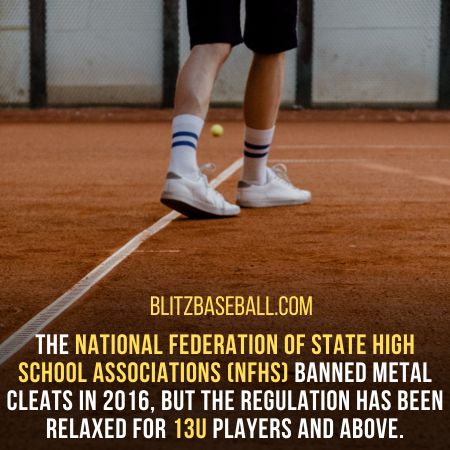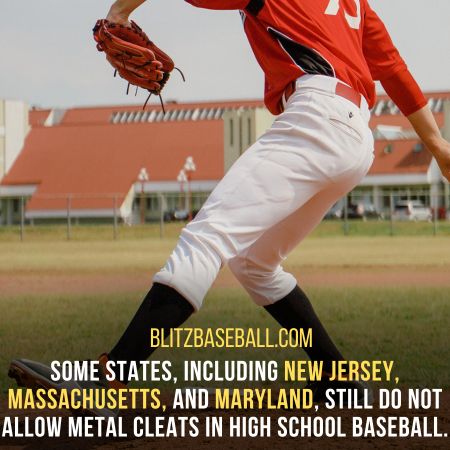Metal cleats have become increasingly popular in high school baseball due to their ability to enhance gameplay. So, can you use metal cleats in high school baseball?
These cleats, similar to those used in soccer and football, feature a thick and cleated outsole that provides excellent traction and helps players maintain grip while running and swinging.
Metal cleats offer numerous advantages such as stability, support, and durability, making them a preferred choice among professional league batters to improve their batting accuracy.
However, the National Federation of State High School Associations (NFHS) implemented a ban on metal cleats in 2016, with some states still prohibiting their use in high school baseball.
This regulation has been relaxed for players aged 13 and above, but there are still concerns regarding potential injuries, increased turf burns, loud noise, and the weight and inflexibility of metal cleats.
Additionally, their use is restricted in various tournaments and leagues to prevent damage to the playing surface and potential injuries to other players.
Therefore, it is essential to understand the regulations, age restrictions, and alternatives to metal cleats in high school baseball.
Key Takeaways
- Metal cleats have become increasingly popular in high school baseball in recent years.
- The National Federation of State High School Associations (NFHS) banned metal cleats in 2016, but the regulation has been relaxed for 13U players and above.
- Some states, including New Jersey, Massachusetts, and Maryland, still do not allow metal cleats in high school baseball.
- Metal cleats can improve batting accuracy and are preferred by many pro-league batters.
Can You Use Metal Cleats In High School Baseball? Permitted Age for Metal Cleats
The permitted age for using metal cleats in high school baseball is 13U and above, as stated by both the National Federation of State High School Associations (NFHS) and the NCAA.
Metal cleats offer several advantages that can significantly impact a player’s performance. Firstly, metal cleats provide superior traction on grass and dirt surfaces, allowing players to have better control and stability while running and making quick movements. This improved traction can lead to enhanced speed and agility on the field.

Secondly, metal cleats have been scientifically proven to improve batting accuracy, making them a preferred choice for many professional league batters.
The added stability and support provided by metal cleats can help players maintain their balance and generate powerful swings.
Overall, the permitted use of metal cleats in high school baseball can positively affect a player’s performance by providing them with the necessary tools to excel on the field.
Metal Cleats and Injuries
Metal cleats have been associated with an increased risk of injuries in the context of high school baseball.
While metal cleats have proven benefits in terms of improving gameplay, they also come with certain drawbacks. Here are four key points to consider:
-
Impact on Gameplay: Metal cleats provide excellent traction on grass and dirt surfaces, which can enhance a player’s speed and agility. They offer stability and support, particularly during quick movements and sharp turns. Moreover, metal cleats have been known to improve batting accuracy, making them a popular choice among professional batters.
Pros of Metal Cleats:
- Metal cleats have a longer lifespan compared to other types of cleats.
- They also provide superior traction and grip, ensuring that players maintain their footing on the field.
- Additionally, metal cleats can enhance a player’s performance by offering stability and support during intense gameplay.
Cons of Metal Cleats:
- One significant drawback of metal cleats is the potential for serious injuries. The metal spikes can cause harm during close interactions between players, such as collisions or sliding into a base.
- Furthermore, metal cleats are heavier and less flexible than other options, which can affect a player’s comfort and mobility.
- They also tend to produce loud noise when walking on harder surfaces.
Tournament Restrictions:
- Metal cleats may not be allowed in some tournaments to prevent damage to the playing surface and potential injuries to other players.
- Tournament organizers often prioritize player safety and fair play, which may lead to stricter regulations regarding footwear.
Overall, while metal cleats offer advantages in terms of gameplay, it is essential to consider the potential risks and weigh them against the benefits before deciding to use them in high school baseball.

Regulations on Metal Cleats
Regulations on metal cleats in high school baseball vary by state and tournament, with some allowing their use while others prohibit them for player safety reasons.
The advantages of metal cleats, such as improved traction and stability on grass and dirt surfaces, have led to their popularity among players. However, the potential for serious injuries and damage to playing surfaces has prompted certain states and tournaments to ban metal cleats.
The impact of these regulations is evident in the restriction of metal cleats for players under 13 years old by the National Federation of State High School Associations (NFHS). This decision aims to prevent potential injuries during close interactions in the fast-paced sport of baseball.
While the use of metal cleats is allowed for players 13U and above, it is important for high school baseball players to adhere to the regulations set by their state and tournament to ensure player safety.
Alternatives to Metal Cleats

One alternative to metal cleats in high school baseball is the use of molded rubber or plastic cleats. These cleats provide a different type of traction compared to metal cleats.
The pros of using molded rubber or plastic cleats include a reduced risk of serious injuries, as they are less likely to cause harm during close interactions between players.
Additionally, they are lighter and more flexible, allowing for increased agility on the field.
However, there are some cons to consider. Molded cleats may not provide the same level of traction on grass and dirt surfaces as metal cleats do.
They also tend to have a shorter lifespan and may need to be replaced more often.
Overall, the impact of metal cleats on performance is subjective and may vary depending on individual preferences and playing conditions.
